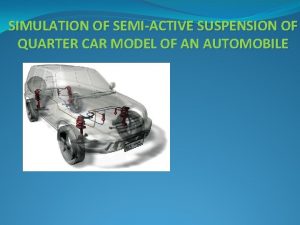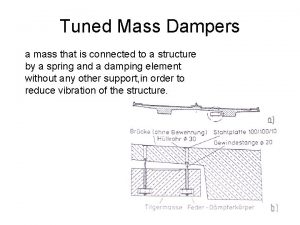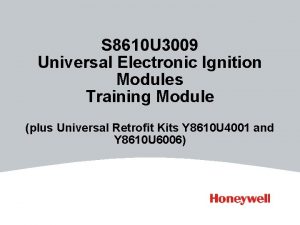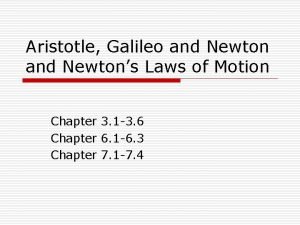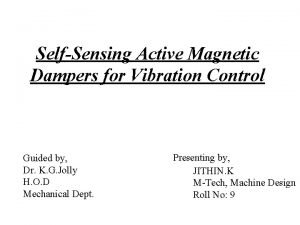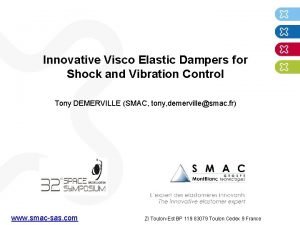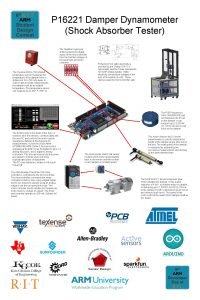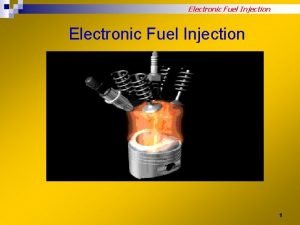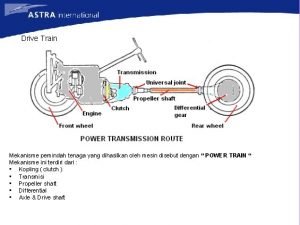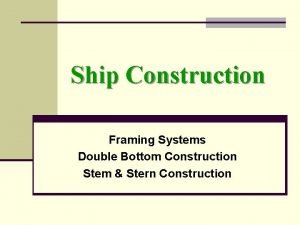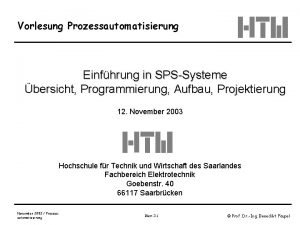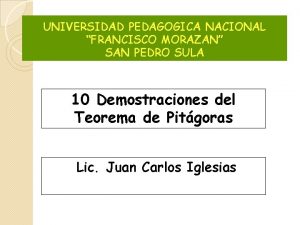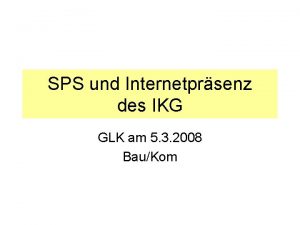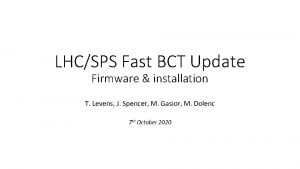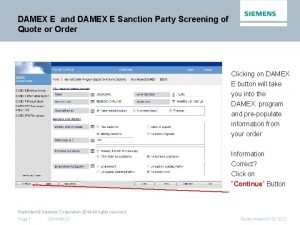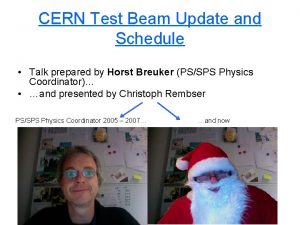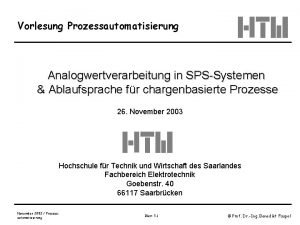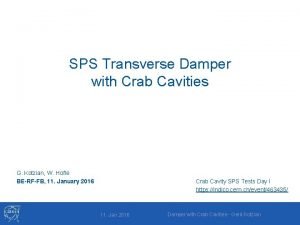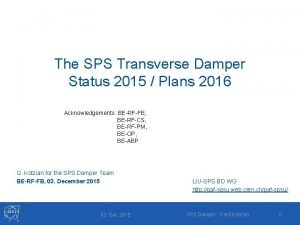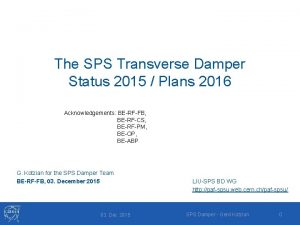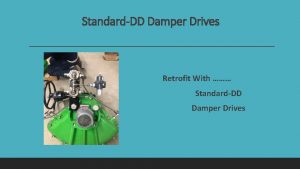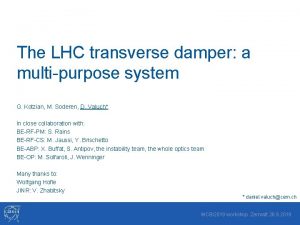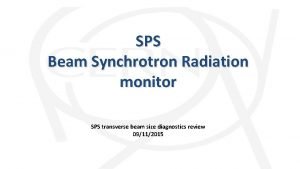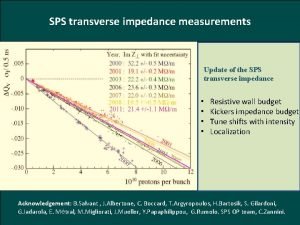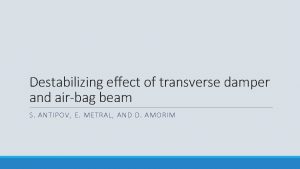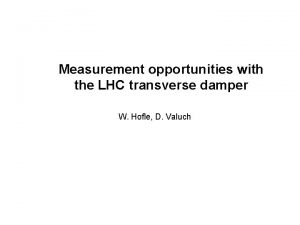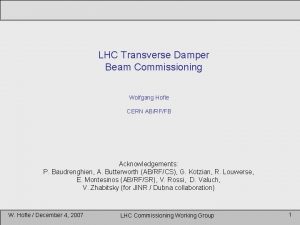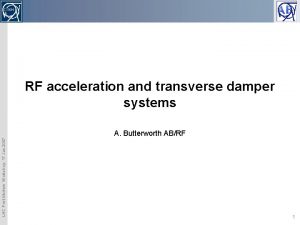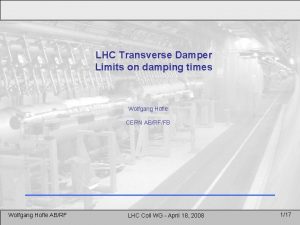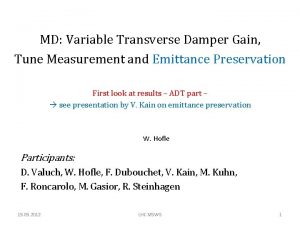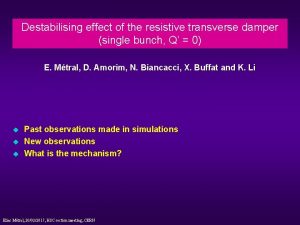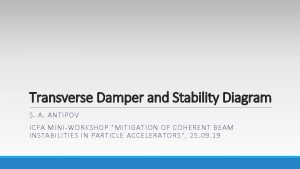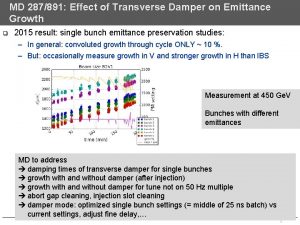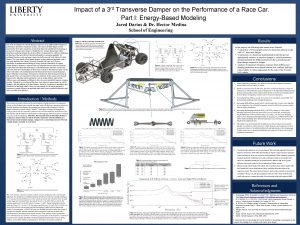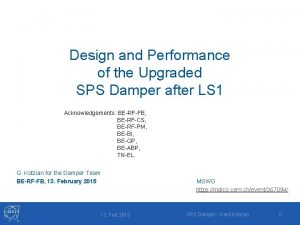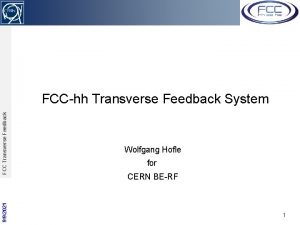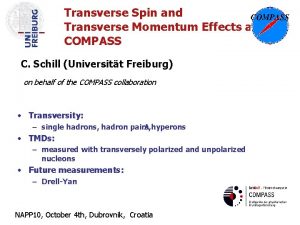SPS Transverse Damper System Overview What is it





























- Slides: 29

SPS Transverse Damper System

Overview • What is it used for ? • How does it work ? • Control and Diagnostics • Electronic details

What is it used for ? • Damping of transverse injection errors • Feedback: to cure transverse coupled bunch instabilities • Excitation of transverse oscillations for beam measurements (Multi-Q) and increase of emittance (blow up)

How does it work ? • A feedback loop including : – Pick-ups (2. 04 => 2. 15) Associated by pairs according to the beam type – A Low Level part (Signal process + Pick-up Mixing + Low Level) – 4 “electrostatic” kickers (H 1, H 2, V 1 and V 2) H 1, H 2 and V 1 Installed in LSS 2 V 2 installed in LSS 2+

Feedback Loop Beam deflector Position monitor BEAM + - Low Level Surface – BA 2

Association of the Pick-ups 2. 04 2. 06 H plane 2. 05 2. 07 V plane LHC 2. 08 2. 10 H plane - Ions (before) 2. 12 2. 14 2. 09 2. 11 V plane - Ions (before) 2. 13 2. 15 Used as spares H plane Fix Target V plane Fix Target

The Pick-ups (position monitors) BDH 2. 04 BDV 2. 05 Shared with BI (MOPOS) but specific electronics

Block Diagram (H 1 & H 2)

Simplified Block Diagram (H 1 & H 2) 2 pick-ups D 2. 12 & Level adjust. Pick-ups Mixing Closed orbit suppr. Delay adjust. Gain LSA 2. 14 Fixed Target beam S Timing ON/OFF Damper H 1 External excitation ( ) Timing ON/OFF Damper H 2 External excitation ( ) BDH 214. 37 Level adjust. Betatron phase adjust. 2 pick-ups 2. 04 D & Level adjust. 2. 06 LHC beam S Level adjust. Closed orbit suppr. Delay adjust. Gain LSA BDH 214. 51

The electrostatic kickers BDH 214. 37 (H 1) BDH 214. 51 (H 2) BDV 214. 57 (V 1) LSS 2 - BDV 221. 76 (V 2) LSS 2 +

Control and Diagnostics • Control New RF Control Application (MMI) Trim Editor Application (LSA) • Diagnostics Oasis Application • Compare with reference signals

New RF Control Application • • More ergonomic All parameters readable Role based access to change settings Synoptic : Experts view / Simplified view for Operation

Block Diagram (H 1 & H 2) LSA 2. 12 & 2. 14 New MMI LSA New MMI 2. 04 & 2. 06 timing Multi-Q

Dampers H 1 & H 2 (simplified) 2 pick-ups D 2. 12 Pick-ups Mixing ‘DGCA’ & 2. 14 Fixed Target beam Level adjust Closed orbit suppr. (Notch Filter) Gain LSA Delay adjust. S Level adjust ‘DGCA’ Timing ON/OFF Damper H 1 External excitation ( ) Timing ON/OFF Damper H 2 External excitation ( ) BDH 214. 37 ‘DPUM’ - p. u. select - Polarity - Phase Betatron phase adjust. 2 pick-ups 2. 04 D ‘DGCA’ & 2. 06 LHC beam Level adjust Closed orbit suppr. (Notch Filter) Delay adjust. S Level adjust ‘DGCA’ Application) - Controlled by the new MMI application - Controlled by LSA (Trim Editor Gain LSA BDH 214. 51

Diagnostics • Observation with OASIS Application: • Delta : difference between the signals of one pick-up (= not normalised transverse position of the beam position * Intensity) • Sum : sum of the signals of one pick-up (= intensity of the beam) • Input : signal leaving the low level • Plates : voltage of the kicker’s plates (= delta signal between the two plates)

Diagnostics Delta Sum Input Plates

Diagnostics • Delta signals + BCT (100 ms/div) • 2. 13 V and 2. 15 V (CNGS beam – Damper V)

Diagnostics • Sum signals (100 ms/div) • 2. 13 V and 2. 15 V (CNGS beam – Damper V)

Diagnostics • Input V 2 and Plates V 2 signals (100 ms/div)

Diagnostics Observation Diagnostic - Damper Trip - Reset and restart - No signals from the Pick-ups (Δ and Σ) - Bad contact in the tunnel - Problem pre-ampli alimentation - Phase error on an ‘Input‘ signal - MMI datas corrupted (software error) - Amplitude difference between 2 ‘Plates’ signals of the same plane - Power Problem - Damping too long - Bad damping - Need more gain (Trim Editor) - Wolfgang’s settings - Bad Tune

Few more details. . • How the signals are treated in the electronic part of the system ?

2. 04 D and 2. 06 D – H plane (LHC Beam - Single Bunch, scope in SR 4)

Pick-up Mixing Main * cos F Aux * sin F Betatron phase advance between p. u. and the kicker has to be = 90°

Pick-up Mixing Vector sum Aux. pu D F Main pu D Vector sum = Main*cos F + Aux*sin F Betatron phase adjustment is done by combining 2 “orthogonal” (~ 88°) signals with good signs and good ratios

After Pick-up Mixing

Low Level • Notch Filter does the difference between 2 turns delete the closed orbit • Delay is to ensure that the signal arrives at the kicker at the right time (right bunch) (Delay = Dt + temps de vol du signal) • LSA Gain to be adjusted with the Energy of the Beam (damping time & losses)

After closed orbit suppression

Before & after Notch

Feedback Loop Beam deflector Position monitor BEAM Low Level Surface – BA 2 1 st turn: Measurements only 2 nd turn: Meas + correct but with orbit offset 3 rd turn: Correction OK
 Peritoneal cavity
Peritoneal cavity Damping coefficient c
Damping coefficient c Damper fire alarm
Damper fire alarm Damper
Damper Honeywell s8610u continuous retry troubleshooting
Honeywell s8610u continuous retry troubleshooting Mono tube damper
Mono tube damper Colt international ltd
Colt international ltd Aristotle galileo and newton ideas about motion
Aristotle galileo and newton ideas about motion Active magnetic damper
Active magnetic damper Trc force
Trc force Viscoelastic damper
Viscoelastic damper Tuned mass damper
Tuned mass damper Shock absorber tester
Shock absorber tester Kode dtc toyota corona
Kode dtc toyota corona Mekanisme penggerak kopling
Mekanisme penggerak kopling Longitudinal and transverse framing system
Longitudinal and transverse framing system Ship framing system
Ship framing system Selbsthaltung sps fup
Selbsthaltung sps fup Universidad pedagogica sps
Universidad pedagogica sps Ikg reutlingen schulportal
Ikg reutlingen schulportal Spsims
Spsims Sps ims
Sps ims Sgs upm
Sgs upm Sps program
Sps program Bibct
Bibct Damex e prüfung
Damex e prüfung Cern testing schedule
Cern testing schedule Sps behavioural competency framework
Sps behavioural competency framework Analogwertverarbeitung sps
Analogwertverarbeitung sps Sps 730
Sps 730

